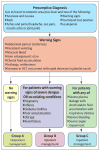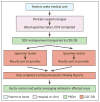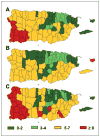Recent Advances in Dengue: Relevance to Puerto Rico
- PMID: 26061055
- PMCID: PMC4587385
Recent Advances in Dengue: Relevance to Puerto Rico
Abstract
Dengue represents an increasingly important public health challenge in Puerto Rico, with recent epidemics in 2007, 2010, and 2012-2013. Although recent advances in dengue vaccine development offer hope for primary prevention, the role of health professionals in the diagnosis and management of dengue patients is paramount. Case definitions for dengue, dengue with warning signs, and severe dengue provide a framework to guide clinical decision-making. Furthermore, the differentiation between dengue and other acute febrile illnesses, such as leptospirosis and chikungunya, is necessary for the appropriate diagnosis and management of cases. An understanding of dengue epidemiology and surveillance in Puerto Rico provides context for clinicians in epidemic and non-epidemic periods. This review aims to improve health professionals' ability to diagnose dengue, and as highlight the relevance of recent advances in dengue prevention and management in Puerto Rico.
Keywords: Dengue; Epidemiology; Public Health.
Conflict of interest statement
The authors have no conflicts of interest to disclose.
Figures




Similar articles
-
Surveillance for Chikungunya and Dengue During the First Year of Chikungunya Virus Circulation in Puerto Rico.J Infect Dis. 2016 Dec 15;214(suppl 5):S475-S481. doi: 10.1093/infdis/jiw245. J Infect Dis. 2016. PMID: 27920177 Free PMC article.
-
Sentinel Enhanced Dengue Surveillance System - Puerto Rico, 2012-2022.MMWR Surveill Summ. 2024 May 30;73(3):1-29. doi: 10.15585/mmwr.ss7303a1. MMWR Surveill Summ. 2024. PMID: 38805389 Free PMC article.
-
Chikungunya cases identified through passive surveillance and household investigations--Puerto Rico, May 5-August 12, 2014.MMWR Morb Mortal Wkly Rep. 2014 Dec 5;63(48):1121-8. MMWR Morb Mortal Wkly Rep. 2014. PMID: 25474032 Free PMC article.
-
Dengue in Puerto Rico: clinical manifestations and management from 1960's to 1987.P R Health Sci J. 1987 Aug;6(2):113-8. P R Health Sci J. 1987. PMID: 3313491 Review.
-
Clinical manifestations of dengue hemorrhagic fever in Puerto Rico, 1990-1991. Puerto Rico Association of Epidemiologists.Rev Panam Salud Publica. 1997 May;1(5):381-8. doi: 10.1590/s1020-49891997000500007. Rev Panam Salud Publica. 1997. PMID: 9180059 Review.
Cited by
-
Surveillance for Chikungunya and Dengue During the First Year of Chikungunya Virus Circulation in Puerto Rico.J Infect Dis. 2016 Dec 15;214(suppl 5):S475-S481. doi: 10.1093/infdis/jiw245. J Infect Dis. 2016. PMID: 27920177 Free PMC article.
-
Cemeteries as sources of Aedes aegypti and other mosquito species in southeastern Puerto Rico.Trop Med Int Health. 2022 Mar;27(3):300-309. doi: 10.1111/tmi.13723. Epub 2022 Mar 2. Trop Med Int Health. 2022. PMID: 35118778 Free PMC article.
-
Estimating dengue under-reporting in Puerto Rico using a multiplier model.PLoS Negl Trop Dis. 2018 Aug 6;12(8):e0006650. doi: 10.1371/journal.pntd.0006650. eCollection 2018 Aug. PLoS Negl Trop Dis. 2018. PMID: 30080848 Free PMC article.
-
Incidence and Risk Factors for Developing Dengue-Associated Hemophagocytic Lymphohistiocytosis in Puerto Rico, 2008 - 2013.PLoS Negl Trop Dis. 2016 Aug 24;10(8):e0004939. doi: 10.1371/journal.pntd.0004939. eCollection 2016 Aug. PLoS Negl Trop Dis. 2016. PMID: 27556807 Free PMC article.
-
Dengue vaccine acceptability before and after the availability of COVID-19 vaccines in Puerto Rico.Vaccine. 2023 Jun 1;41(24):3627-3635. doi: 10.1016/j.vaccine.2023.04.081. Epub 2023 May 5. Vaccine. 2023. PMID: 37173267 Free PMC article.
References
-
- World Health Organization. Dengue : Guidelines for diagnosis, treatment, prevention, and control. Geneva, Switzerland: World Health Organization; 2009. Special Programme for Research and Training in Tropical Diseases.
-
- Deen JL, Harris E, Wills B, et al. The WHO dengue classification and case definitions: Time for a reassessment. Lancet. 2006;368:170–173. - PubMed
-
- Bandyopadhyay S, Lum LCS, Kroeger A. Classifying dengue: A review of the difficulties in using the WHO case classification for dengue haemorrhagic fever. Trop Med Int Health. 2006;11:1238–1255. - PubMed
Publication types
MeSH terms
Grants and funding
LinkOut - more resources
Full Text Sources
Medical
